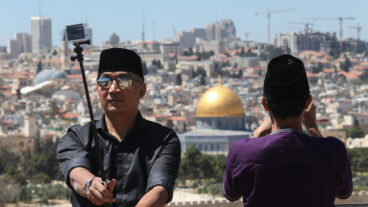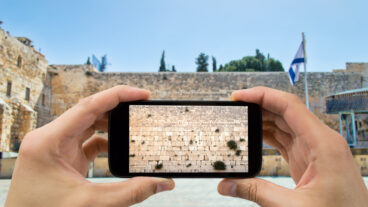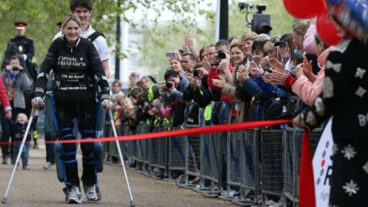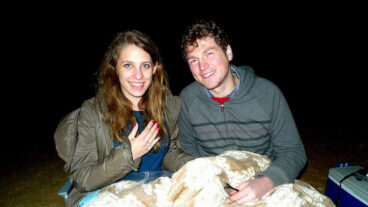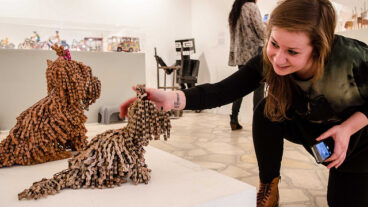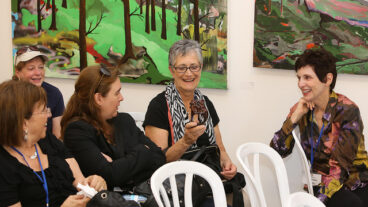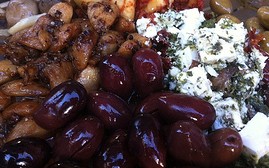Whether it is in New York or Tel Aviv, the results of terror are the same.As a physician, I am no stranger to human suffering. And I am no stranger to the worst kinds of diseases. But the disease of terrorism may be one of the most horrific.
I saw the results of terrorism in America up close and personal for a period of almost two months following what we experienced on September 11. I will certainly not forget the eerie feeling of an evacuated downtown Washington. I stood on the top steps between those two giant marble pillars of the Red Cross on 17th Street, our big headquarters building, on September 11th.
On that afternoon I looked around and saw deserted buildings. I saw streets without cars, without pedestrians. The quiet was broken by the military helicopters that were circling above. The only other humans in this panorama were the police, who were blocking off the streets around us with yellow tape, and the snipers in their black jackets and helmets, very much like the ones I saw coming in, that were perched on top of that evacuated White House, as the President was somewhere in the skies in Air Force One, not sure where he could land. This is America.
I will not forget the Pentagon that I saw that very evening. This mighty symbol of our national security. It was in flames, partly collapsed as if it had been hit by an earthquake. The spotlights on that evening magnified this horrible, hideous scene. The hoards of firefighters on extended ladders were swarming all over the roof of that injured building.
They seemed so little and so vulnerable against this monstrous terrorist destruction.
The plane, that American plane filled with innocent life, that was turned into a weapon of mass destruction by utter evil, that plane could not be seen. I looked so hard for it. Some told me that it had melted, making the site somehow even worse: a crematory for the almost 200 souls who faced a terrifying death only a few hours before.
I will not forget the spontaneous outpouring of Americans from all walks of life to give a piece of themselves, to give some blood, knowing full well that there were no survivors or almost no survivors, but knowing that this was the beginning. This was the beginning of a war. This was not the end.
Our headquarters, those big marble buildings, became a temple of grieving as hundreds sat in the waiting rooms from early in the morning until midnight day after day, somberly talking to their neighbors.
One afternoon I asked our choir to serenade the group. As the choir sang “God Bless America,” people started to embrace, to hug, to cry. And as the song crescendoed, they spontaneously stood up almost as one group and they cheered, some standing on their seats. They stood up with passion. They stood up with an air of defiance. They would prevail and they would not cower. And that, indeed, is the response to terrorism. That is the response to terrorism that we Americans felt. In my entire life in medicine, I have never once seen a medical waiting room filled with people cheering.
But my most unforgettable experience after 9/11 was a simple encounter with a mother in New York two days after the attack. Amid a crush of people in search of missing loved ones, she stood patiently waiting in line in unbelievable heat to give information about her 22-year-old daughter who worked on the 100th floor of the World Trade Center. This stoic mom, a small Asian woman about my age, beamed as she told me about her daughter, the economics major, who recently graduated from college.
To her, I was not only the Red Cross doctor, but also a mom. When she showed me her pictures, I was utterly taken aback. Her smiling, bright-eyed daughter looked just like mine. I told her I had a 22-year- old who also just graduated and they looked alike. And at that point we spontaneously embraced and suddenly she began to sob uncontrollably. I felt her unbearable suffering, and I did what I was trained not to do. I sobbed with her.
In my life as a doctor I have seen family grief, I have seen suffering so many times. But never have I seen this kind of agony. To me, then and now, that mom represents everything that is hideous about terrorism. And it doesn’t matter if it is New York or Tel Aviv, whether it is a terrorist attack on a trade tower overlooking the Statue of Liberty or a terrorist slaughter at a Passover gathering celebrating the deliverance of the Jewish people from slavery. It is all the same.
If we only remember 9/11 as we must, we understand the terrorism that Israel faces every day. Only worse because Israel’s very existence as a nation and as a people is threatened every day.
For 50 years Israel and Magen David Adom, its national humanitarian society has been excluded from the Red Cross International Movement, which is based in Geneva. What possibly could cause the exclusion? An exclusion which is the betrayal of the fundamental principles of humanitarianism, of universality, and of impartiality
It is unjust and it is immoral. And it is one of those injustices and immoralities that can only singe one’s sole. It must be remedied and it cannot be remedied by political. It cannot be remedied by schmoozing. It cannot be remedied by nice talk. It must be remedied by action, which is so simple to do.
And by remedying it, it is more than the admission of the isolated Magen David Adom into a humanitarian society it should have been part of, and indeed, functionally, was part of for 50 years. But it is a symbol that will have a value that goes way beyond the entrance of Magen David Adom. It will be a major symbolic step moving us towards fairness and justice.
In in the hideous events of 9/11, America’s soul was seared, seared by hate and injustice. Our liberty, our freedom and our security were threatened and we all felt it. We must never forget: this is ongoing. It is an ongoing battle for we as Americans, but we must also never forget our ally Israel who endures this reality every day
Dr. Healy delivered this speech to the 2002 AIPAC Policy Conference.




